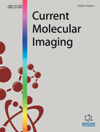- Home
- A-Z Publications
- Current Molecular Imaging (Discontinued)
- Previous Issues
- Volume 4, Issue 2, 2015
Current Molecular Imaging (Discontinued) - Volume 4, Issue 2, 2015
Volume 4, Issue 2, 2015
-
-
In vivo MRS of Muscle, Liver, Heart and Other Organs: A Review of Techniques and Applications
More LessAs MRI has been used in biomedical research and medicine since the 1970s, Magnetic Resonance Spectroscopy (MRS) has been employed to study biochemical alterations in living animals and humans. By taking advantage of its noninvasive nature, 1H, 13C and 31P MRS are being actively utilized in clinical and biomedical studies to detect lipids, metabolites, and/or kinetic information, such as acetyl carnitine content and AT Read More
-
-
-
Brain Proton Magnetic Resonance Spectroscopy: A Review of Main Metabolites and its Clinical Applications in Gliomas
More LessAuthors: Xiaofei Lv, Zhengchao Dong, Jing Li, Rong Zhang, Chuanmiao Xie and Zhenfeng ZhangMagnetic Resonance Imaging (MRI) is a mature methodology that has been widely used for the evaluation of brain gliomas. Conventional MR imaging can provide morphometric characterization of gliomas, whereas proton Magnetic Resonance Spectroscopy (MRS) provides metabolite information for gliomas non-invasively in vivo. In the application to brain gliomas, proton MRS plays an important role in diagnosis, differ Read More
-
-
-
In vivo Proton Magnetic Resonance Spectroscopy and its Applications in Autistic Disorder
More LessAuthors: Zhengchao Dong, Yudong Zhang, Xuewu Zhang and Jianwu LiProton Magnetic Resonance Spectroscopy (1H MRS) of the brain is a versatile technique for the study of brain metabolism and brain function and has found wide applications in biomedical research and clinical diagnosis. Proton MRS is capable of measuring concentrations of brain chemicals, probing cellular energetic mechanism, membrane metabolism, and mitochondrial function, thus allowing us to understand the neuro-pa Read More
-
-
-
CEST MRI for Molecular Imaging of Brain Metabolites
More LessAuthors: Kejia Cai, Rongwen Tain, Xiaohong J. Zhou and Charles E. RayAs a sensitive MRI method, Chemical Exchange Saturation Transfer (CEST) MRI based on endogenous contrast has been increasingly utilized for molecular imaging of various metabolites. Among these applications, the authors have described CEST MRI for molecular imaging of brain metabolites in this review, including brain glutamate, the most abundant excitatory neurotransmitter; creatine, a key molecular of bioen Read More
-
-
-
Updates on the Role of FDG-PET/CT in Gynecological Malignancies
More LessAuthors: Rima Tulbah, Nouf Malibari, Marc Hickeson and Robert LisbonaPET/CT has had an evolutionary role in Oncology. Gynecological malignancies have been increasing in incidence in the last decades. Delay in diagnosis and management have led to worsening prognosis among the patients. Lowering the threshold in suspecting these tumors, may significantly improve the patients’ overall survival. In this review we will address the role of FDG-PET/CT in diagnosing, staging, assessing Read More
-
-
-
FDG-PET/CT Identifies Inflammatory Activity and Presence of Fistulas in a Patient with Crohn´s Disease
More LessAuthors: Irina Wimmer, Gregory Minear, Reinhard Brustbauer, Andreas Mayer, Peter Gotzinger and Karl DamCrohn's Disease (CD) is a chronic inflammatory bowel disorder which can lead to complications like fistulas, strictures and abscesses. It is difficult to differentiate between chronic fibrotic and acute inflammatory processes with current non-invasive and invasive methods. FDG-PET/CT might help to identify active inflammatory processes and morphological information via one examination. It is a case report of a 22 year old woman di Read More
-
-
-
FDG-PET Studies of Semantic Dementia; A Review
More LessAuthors: Nobuhiko Miyazawa and Toyoaki ShinoharaSemantic Dementia (SD) is classified as a type of Frontotemporal Lobar Degeneration (FTLD) characterized by progressive impairment of conceptual knowledge, accounting for approximately 30% of cases of FTLD. Clinical symptoms and brain Magnetic Resonance (MR) imaging are helpful to reach the diagnosis in the advanced stage, but brain positron emission tomography with [18F] Fluoro-2-Deoxy-D-Glucose (FDG Read More
-
Volumes & issues
Most Read This Month
Article
content/journals/cmi
Journal
10
5
false
en


